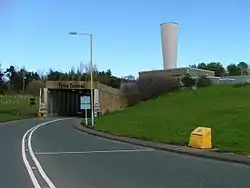Tyne Tunnel
The Tyne Tunnel is the name given to two 2-lane vehicular toll tunnels under the River Tyne in North East England. Completed in 1967 and 2011, they connect the town of Jarrow on the south bank of the river with North Shields and Howdon on the northern end. The tunnels are 7 miles (11 km) downstream and to the east of Newcastle upon Tyne and form part of the A19 road.

History
A scheme for the construction of a set of three tunnels under the Tyne was put forward by the Durham and Northumberland county councils in 1937. After prolonged negotiations with the Ministry of Transport, the scheme was approved in 1943. The Tyne Tunnel Act, the legislative instrument necessary to enable the construction of the tunnels, received royal assent in 1946. Postwar restrictions on capital expenditure delayed the construction of the vehicular tunnel, but work started on the smaller tunnels for pedestrians and cyclists in 1947.
First Tyne motor vehicle tunnel
 | |
| Overview | |
|---|---|
| Crosses | River Tyne |
| Start | Jarrow |
| End | Howdon |
| Operation | |
| Opened | 1968 |
| Closed | 25 February 2011 |
| Reopened | 21 November 2011 |
| Owner | North East Combined Authority |
| Operator | TT2 Ltd |
| Traffic | Motor vehicles |
| Toll | £1.80 (Cars) |
| Technical | |
| No. of lanes | 2 |
| Operating speed | 30 mph (48 km/h) |
The vehicle tunnel is 1 mile or 5,500 feet (1,700 m) long and has a diameter of 31 ft 3 in (9.5 m) with a roadbed 24 ft (7.3 m). It was built by Edmund Nuttall Limited and was opened by Queen Elizabeth II on 19 October 1967, but commenced operational use only in 1968, on completion of the northern link roads. It was designed to handle 25,000 vehicles per day. The original toll for cars was 2s 6d (12.5p). On completion of the second Tyne road tunnel, which opened with a single lane in each direction, the original 1967 Tyne Tunnel closed in February 2011 for a complete revamp, which included the installation of a safety corridor throughout its length. Once this work was complete, it reopened in November 2011 as the northbound tunnel, leaving the new tunnel to handle southbound traffic.
Second Tyne motor vehicle tunnel
 | |
| Overview | |
|---|---|
| Route | A19 |
| Start | Howdon |
| End | Jarrow |
| Operation | |
| Work begun | 2008 |
| Opened | 25 February 2011 |
| Owner | North East Combined Authority |
| Operator | TT2 Ltd |
| Traffic | Motor vehicles |
| Toll | £1.80 (Cars) |
| Technical | |
| No. of lanes | 2 |
| Operating speed | 40 mph (64 km/h) |

Tunnel usage is forecast to rise to 43,000 per day by 2021. In March 2004 the Tyne and Wear Integrated Transport Authority launched a scheme to build a second, £139 million tunnel. The tunnel is slightly to the east of the existing tunnel, and the pairing allows each tunnel to serve two lanes of traffic, each travelling in the same direction; the original tunnel had two single lanes of traffic in opposing directions, representing an avoidable risk. The UK government gave the go-ahead for the scheme in July 2005. Construction work started in spring 2008, with the new tunnel opening to two-lane bi-directional traffic on 25 February 2011, at which point the original tunnel closed for a ten-month refurbishment.
The timeline for the new Tyne Tunnel was as follows:
- Transfer tunnels and staff to concessionaire: 1 February 2008
- Main work started: Spring 2008
- New tunnel opened: end of February 2011
- Existing tunnel closed for refurbishment: end of February 2011
- Both existing and new tunnel fully operational and open: end of November 2011. Originally this was planned for January 2012; however, both refurbishment of the old tunnel was completed earlier than expected and both tunnels were open by lunchtime on 21 November 2011.[1]
The tunnel was constructed under a private finance initiative 30-year "design–build–finance–operate" contract by Bouygues Construction.
Onshore sections of the new tunnel were built using the cut-and-cover method. Under-river sections of the tunnel were prefabricated, floated into position, immersed into a dredged trench, and covered with rocks. By beginning of November 2009, the land approaches to the tunnel had been excavated, and construction of the tunnel, in four 300-foot (90 m) sections, had been completed nearby. The dredger used to excavate the river section of the tunnel cutting arrived on site on 4 November 2009 to excavate 400,000 cubic metres of sediment, which was used to infill the defunct Tyne Dock, reclaiming 13 acres (53,000 m2) of land for use by Port of Tyne.[2] Both ends of the tunnel finally met on 26 May 2010.
Safety
The new tunnel is fitted with a fixed fire suppression system which releases a fine mist to contain fires to help motorists leave safely and to prevent damage to the tunnel structure. There is also a separate evacuation corridor which runs adjacent to the main tunnel. The old tunnel, now fully refurbished, includes many of the same safety features.
The New Tyne crossing is claimed to be one of the safest in the UK,[1] thanks to a state-of-the-art active fire suppression system which is now included in its design. It is the first in the UK to be fitted with a water mist active fire suppression system, and will further ensure the safety of thousands of people who will travel through it every day.
The original 1960s-built tunnel was slated as of one of the least safe in Europe in 2000, according to a study. Inspectors visited 25 major tunnels around Europe after fire devastated the Mont Blanc Tunnel under the Alps between France and Italy. The Tyne Tunnel was officially rated as "poor" and languished near the bottom of the European league table. The inspectors found it had no automatic fire alarm system, poor lighting, no laybys or hard shoulder, and an emergency walkway that could be reached only by able-bodied people. They also criticised its smoke extraction system. These deficiencies were addressed during the refurbishment of the original road tunnel in 2011.
Tolls
As of 2019, the toll charge for cars is £1.80; vans, trucks, and buses, £3.60.[3] Motorcycles use the tunnel free and Blue Badge holders can apply for an exemption account.[4] A 10% discount is available to Tyne Tunnel permit holders. The permits are passive electronic discs stuck to the inside of the vehicle's windscreen, which are electronically read by the toll booth's scanner, whereupon the toll is debited from the permit-holder's account. Automatic number-plate recognition technology is also used.[5]
Tyne cyclist and pedestrian tunnels
References
- "New Tyne Crossing Web-site". Retrieved 16 January 2012.
- "Arrival of New Tyne Crossing dredger imminent". Materials Handling World Magazine. 4 November 2009. Archived from the original on 8 November 2009. Retrieved 4 November 2009.
- "Tyne Tunnel toll charges – Tyne Tunnels". TT2 Limited. Retrieved 16 July 2019.
- "Toll Exemption Accounts – Tyne Tunnels". TT2 Limited. Retrieved 16 July 2019.
- "How to use Pre-paid Accounts – Tyne Tunnels". TT2 Limited. Retrieved 16 July 2019.
- New Civil Engineer - 25 March 2004, pp. 10 & 12.
External links
| Next vehicle crossing upstream | River Tyne | Next vehicle crossing downstream |
| Tyne Bridge A167 and |
Tyne Tunnel Grid reference NZ329660 |
None North Sea |
| Next crossing upstream | River Tyne | Next crossing downstream |
| Gateshead Millennium Bridge Footbridge |
Tyne Tunnel Grid reference NZ329660 |
Shields Ferry Pedestrian ferry and |